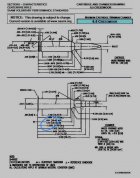dellet
Gold $$ Contributor
You need a good lesson in basics, before you get hurt.
Your max trim length for your chamber need to be at .010” less than factory spec to compensate for the short chamber.
Then you need to drop about 5% below minimum charge weight and work up your load. Your max load might make it to 5% less than book max, if you’re lucky.
Look at the SAAMI drawings and compare your measurements to the specs.
You do not have a 6.5 Creedmoor. You have a 6.5 almosta bomb.
Trying to shoot max loads in a chamber known to be short, because it won’t close on a Go-Gauge, is insane.
Your max trim length for your chamber need to be at .010” less than factory spec to compensate for the short chamber.
Then you need to drop about 5% below minimum charge weight and work up your load. Your max load might make it to 5% less than book max, if you’re lucky.
Look at the SAAMI drawings and compare your measurements to the specs.
You do not have a 6.5 Creedmoor. You have a 6.5 almosta bomb.
Trying to shoot max loads in a chamber known to be short, because it won’t close on a Go-Gauge, is insane.












